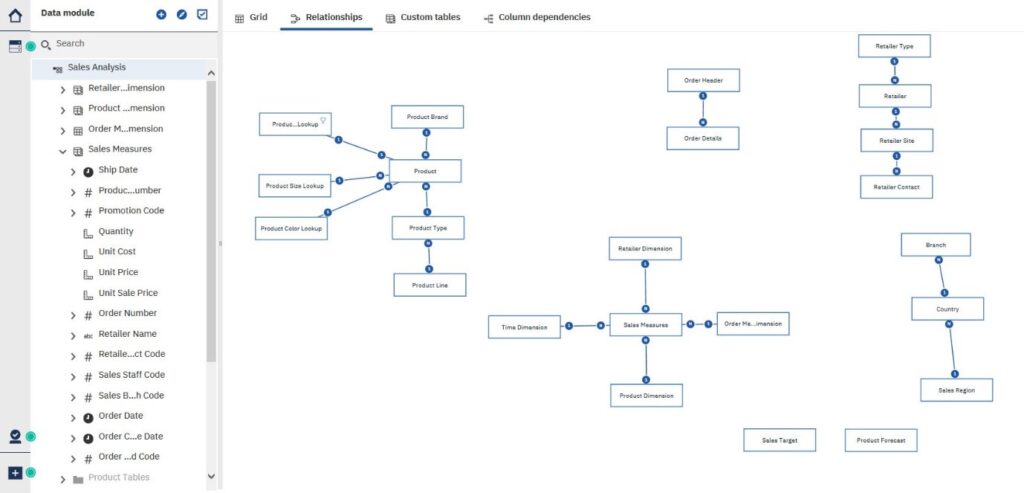
Framework Manager versus Data Modules
Framework Manager versus Data Modules
When you look back at the history of IBM Cognos tools even before IBM acquired Cognos Inc some years ago there was a history of good ideas that kept being developed from humble beginnings. Take Framework Manager, for example, its humble beginnings came from a tool called Architect (not the TM1 Architect) that was going to revolutionise Metadata Management and replace good old Impromptu. Now, some years later, we see history repeating itself in the form of Data Modules.
Data Modules began life in Version 10.2 of IBM Cognos BI as a quick way of getting files into IBM Cognos and creating rapid BI reporting from Spreadsheets, CSV files, etc. Whilst take-up of that functionality was slow in Version 10 since the creation of Cognos Analytics the development of Data Modules has gained pace with continual functional releases. It is in a position today where it is a genuinely full functional Metadata Management tool with capabilities that not only equal those of Framework Manager but exceed it in many ways.
Common Features
In many ways, both tools do common tasks well. When we refer to common tasks, it’s things such as:
- Importing tables
- Creating Relationships
- Merging tables together
- Aggregating data
- Transforming data
- Providing cross-grain facts
- Aliasing, creating views and other table manipulations
- Creating Hierarchical Structures
- Providing a level of security and governance
However, one of the things I have been very impressed with is the speed of Data Modules to get something up and running with little effort. Taking the standard samples database, I was able to bring in product-related tables, create the relationships and create a conformed Product Dimension in a very short space of time. Previously, in Framework Manager, we could achieve the same outcome but a lot more work would have been needed.

The whole user interface seems a lot fresher and more consistent. Anyone who has battled with Framework Manager and getting the relationships to show in an organised form will notice that in Data Modules the diagrams stay exactly where you want them and are fully flexible.

Whilst Data Modules and Framework Manager share a really solid foundation of features there are a few standout features that Data Module has which differentiate it from Framework Manager.
Features like:
- Data Cleansing (external files only)
- Measure Binning
- Attribute Grouping
- AI-driven model creation (useful if table naming is consistent)
- Special Time Category generation for measures
- Special Time Category filtering
- In Memory View Tables
- Multi Data Module Integration
- Column Dependencies
- Navigation Paths
Of all the differentiating features some of those deriving greatest benefit have to be the ability to add reference to another Data Module (especially for Confirmed Dimensions and Special Time Categories), the in-memory view tables to combine data into dimension and fact tables, measure binning whereby we can group measure values into groups and most importantly Column Dependencies which I consider to be a massive upgrade on the previous functionality provided by determinants.
The cleaning of data is useful but could be achieved outside of the tool with a bit of work.

Framework Manager Only Features
With each release of Data Modules, the list of outstanding features to be implemented is reduced. I now consider there to be only three features that I used in Framework Manager that are not in Data Modules yet!
These are:
- Object Security
- Dimensionally Modelled Relational (DMR)
- Parameter Maps
Of these features, I would say all this functionality will appear in Data Modules at some point but these are not so regularly used. Object Security can be overcome by hiding tables from all users and only making discreet Data Modules available in Team Content for particular areas of the business (i.e. Sales for Sales personnel, Profit and Loss for Finance Personnel). Previously, we have used Framework Manager for providing one Metadata Model for all areas of the Business. Data Modules should be considered as providing smaller more functional Modules such as Sales, Inventory, Purchasing, etc.
DMR functionality cannot be provided in Data Modules yet. The nearest we can get is to create a star schema from the database in the Data Module and build reporting from that. With the ability to add special time categories as mentioned earlier might negate the use of DMR going forward. We can also use Navigation Paths in Data Module to provide a guided way of drilling up and down which can be used in Dashboarding.
With Parameter Maps, by looking at an external data source to bring in the equivalent of the parameter map may give the Data Module the same functionality. However, this does depend on how and why you are using the parameter map.
Conclusion
So, if you had asked me which tool to use 12 months ago I would have stated Framework Manager and I still would IF you are using a Cognos Analytics release before 11.1. However, the development work is undertaken by IBM on Data Modules since that point and clearly the ongoing efforts going forwards mean that Data Modules is the way to go in the future.
Clearly you don’t need to ditch your existing Framework Models, IBM has already indicated that Framework Manager will be maintained but NOT enhanced going forwards. I heard that there are plans to provide a migration to Data Modules but as the products are quite different, I wouldn’t recommend taking that route.
Instead, plan ahead, and start any new projects around Data Modules unless you absolutely need one of the three outstanding functions listed earlier. Utilise the Date Dimension generation tools to get your corporate calendar into a data module as soon as possible and make use of the special time category functionality along with column dependencies. This will make your development cycle so much shorter.
Also, stay ahead in the Cognos Analytics release cycle, development on Data Modules is coming through at a rapid pace and some functionality that used to take time to do now takes only a few mouse clicks in the latest release.
Feel free to share your experiences with me, it’s an exciting journey that still has quite a few miles to go.












